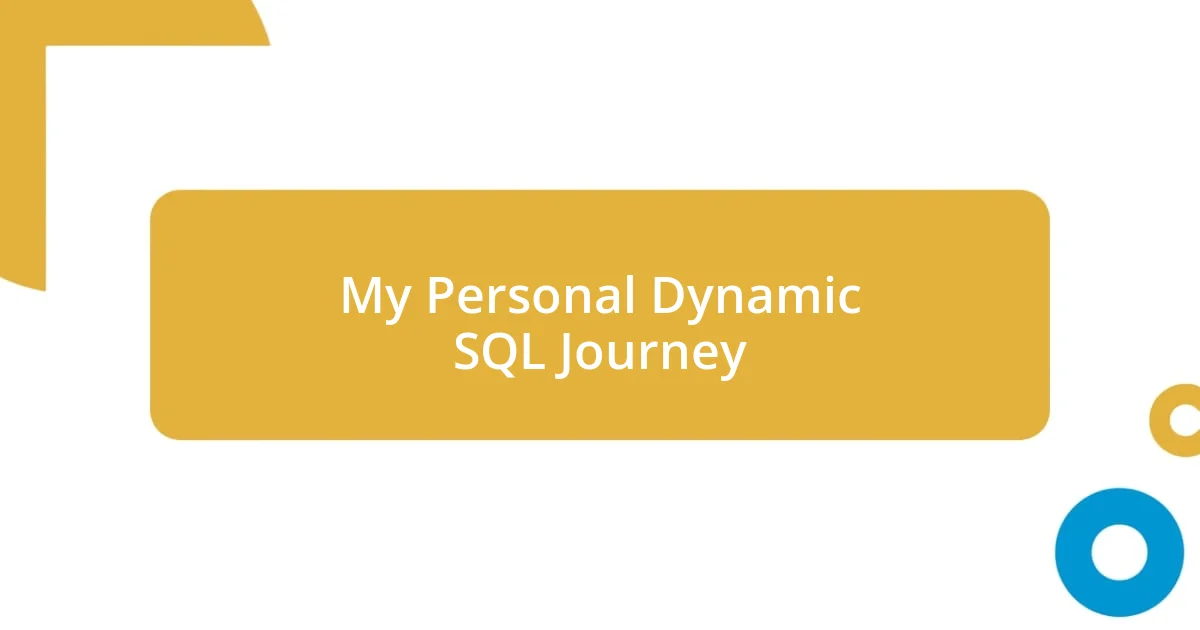Key takeaways:
- Dynamic SQL offers flexibility, allowing for on-the-fly adjustments to queries while enhancing user experience through customizable filtering options.
- Security and performance are critical when using dynamic SQL; adopting best practices such as parameterization and input validation is essential to mitigate risks.
- Embracing dynamic SQL can lead to significant project improvements and user satisfaction, but it also presents challenges like debugging difficulties and performance optimization needs.

Understanding Dynamic SQL Benefits
One of the standout benefits of dynamic SQL is its flexibility. I can’t tell you how many times I’ve been faced with a requirement that changed midway through development. With dynamic SQL, adjusting my queries on the fly was a breeze. I could modify the parameters without having to rewrite lengthy static queries, saving me both time and headache.
Another advantage that stands out is the ability to create complex queries that adapt to varying user inputs. I remember a project where users could filter data based on multiple criteria. Using dynamic SQL, I was able to craft a seamless experience, allowing users to specify what they wanted without coded limits. It’s rewarding to see how something as simple as dynamic queries can enhance user satisfaction.
Moreover, let’s not overlook the potential performance boosts. I often find that dynamic SQL can optimize query performance by leveraging execution plans more effectively. Have you ever had one of those moments where you realize that a minor tweak in your SQL can lead to major efficiency gains? It’s exhilarating when you see it all come together, making your database interactions not just functional but fast and effective.

Common Uses of Dynamic SQL
Dynamic SQL finds its usefulness in a variety of scenarios that enhance both efficiency and usability. A common use I’ve encountered is conditional query execution. Whenever I had to build reports where the fields and tables depended on user selections, dynamic SQL came to the rescue. I remember working on a project where we needed to pull different metrics based on the department chosen. It’s satisfying to see how a few lines of code can produce vastly different outputs, tailored to specific requests.
Another prevalent area is in developing stored procedures. Here’s something I learned firsthand: crafting stored procedures with dynamic SQL allows for great adaptability. On one occasion, I created a procedure that could handle multiple table names as input parameters. It not only reduced redundancy in my code but also streamlined the entire reporting process, which was immensely appreciated by my colleagues. I truly believe that the power of dynamic SQL in stored procedures is often underestimated.
Dynamic SQL is also incredibly useful in building interfaces for user-generated queries. If you’ve ever faced the challenge of letting users customize their search, you’ll appreciate this. I recall a web application that allowed users to define their criteria for database searches via a front-end interface. By employing dynamic SQL, I was able to generate the necessary queries on the backend seamlessly. This capability didn’t just improve the user experience; it transformed the way users engaged with data, making them feel empowered and in control.
| Use Case | Description |
|---|---|
| Conditional Query Execution | Allows developers to generate different SQL queries based on user inputs, enhancing flexibility. |
| Stored Procedures | Facilitates adaptable stored procedures that accept table names or fields as parameters, reducing code redundancy. |
| User-generated Queries | Enables users to define their search criteria through interface, resulting in more personalized data interactions. |

Best Practices for Dynamic SQL
When working with dynamic SQL, maintaining security and performance is paramount. From my experience, one critical best practice is to always use parameterized queries. This approach not only protects against SQL injection attacks—something I once encountered—but also simplifies debugging and enhances performance. I can recall a project where avoiding parameterization led to a security breach that was both stressful and preventable. Relying on parameters helped me avoid those pitfalls and kept my queries efficient.
Here are some additional best practices to consider when using dynamic SQL:
- Validation of Input: Always validate and sanitize user inputs before incorporating them into your queries to prevent injections.
- Limit the Use of Dynamic SQL: Use dynamic SQL sparingly; if a static query suffices, stick with it to maintain readability and performance.
- Error Handling: Implement robust error handling to catch and address problems that may arise with dynamic queries.
- Set Execution Rights: Limit the execution rights of the user executing dynamic SQL to minimize risk and potential damage.
- Use Appropriate Database Permissions: Grant only the necessary permissions needed to execute the dynamic queries, which can safeguard sensitive operations.
By adhering to these guidelines, you can navigate the complexities of dynamic SQL with greater confidence while ensuring your applications remain secure and efficient. I often reflect on how these small changes can create a significant impact on project outcomes.

My Personal Dynamic SQL Journey
When I first started using dynamic SQL, I was both excited and a bit intimidated. I still recall that one late night when I was tasked with creating a complex report that had to adapt to varying user inputs. As I pieced together my first dynamic query, an overwhelming sense of achievement washed over me—after hours of trial and error, I managed to produce a report that dynamically adjusted its fields based on the user’s selections. Have you ever felt that thrill of solving a difficult puzzle? That’s how I felt that night.
One particular project stands out in my mind. I had to develop a feature for a client dashboard that allowed users to select metrics and drill down into details based on their needs. Initially, I struggled with static queries, but once I embraced dynamic SQL, it transformed the entire approach. I remember watching users interact with the new feature, their eyes lighting up as they navigated effortlessly through the data. It was gratifying to witness firsthand how empowering the right tools can be.
Reflecting on my journey, I think about the times I neglected best practices and faced challenges because of it. I learned the hard way about security vulnerabilities, leaving me anxious every time a new release was due. If only I had recognized the importance of parameterized queries sooner! Now, I advocate for mindful and secure coding practices, ensuring that I not only create powerful queries but also protect the integrity of my projects. What lessons have you learned on your journey?

Challenges Faced with Dynamic SQL
Dynamic SQL certainly presents unique challenges that can sometimes be daunting. One of my biggest struggles was grappling with performance issues. I remember a particular incident where an overly complex dynamic query slowed down the entire application. It was frustrating to see users waiting for results, and I found myself constantly optimizing portions of the query. Has anyone else been in that situation where your creation turns against you?
Additionally, I frequently dealt with difficulties surrounding debugging. When errors occurred in dynamically generated SQL, pinpointing the source proved to be a headache. One time, I spent hours trying to trace a bug only to find it was due to a missing parameter. I learned that logging the final SQL statements before execution can save a lot of time and stress—do you incorporate similar measures in your workflow?
Lastly, managing security risks remains an ongoing challenge. I recall a tense moment when I unwittingly exposed sensitive data due to insufficient input validation. That experience taught me the vital importance of rigorous input checks. It’s essential to create a culture of security awareness, but I’ve found that sharing my experiences with colleagues often sparks valuable discussions on best practices. Have you ever shared a slip-up that turned into a learning opportunity for your team?

Real-Life Dynamic SQL Examples
One day, I was tasked with allowing users to filter data for a quarterly sales report based on various criteria. By utilizing dynamic SQL, I turned that challenging request into a user-friendly interface. I remember the excitement in the room when stakeholders realized they could customize their reports on the fly. It felt like handing them a magic wand; have you ever witnessed that kind of transformation in your work?
In another project, I needed to implement a search feature for our product catalog where users could search by categories, price ranges, and ratings. I crafted a dynamic query that seamlessly adjusted based on the user’s inputs, significantly improving the user experience. When I saw the satisfaction on users’ faces as they found their desired products without frustration, it made my efforts worthwhile. What about you? Have you felt a similar joy when seeing your work genuinely help others?
There was also a memorable incident where I had to prepare a dynamic report for a board meeting just hours before the presentation. I quickly constructed a SQL query that enabled the team to view critical metrics in real-time. The rush of adrenaline as I fine-tuned that query was exhilarating, especially when it successfully generated the exact insights the board needed. Have you ever had to think on your feet like that, where success hinged on your ability to adapt quickly?

Conclusion and Future Insights
As I reflect on my journey with dynamic SQL, I’ve realized that, despite its challenges, the rewards often outweigh the difficulties. Each struggle—be it performance issues, debugging nightmares, or security risks—shaped my understanding and approach. Are there moments in your career where a particular challenge led to significant growth? For me, those moments have truly defined my path.
Looking ahead, I believe the potential of dynamic SQL continues to evolve, especially with advancements in database technologies. I’m eager to explore how AI and machine learning can enhance dynamic querying and automate performance optimizations. Have you considered how these innovations could change the way we approach SQL? The future is undeniably exciting, and I can’t wait to uncover new possibilities.
In conclusion, my experiences have instilled a strong belief in the importance of adaptability and vigilance when working with dynamic SQL. I plan to keep honing my skills and sharing insights with colleagues, fostering a culture of continuous learning. How do you envision your future in this dynamic field? Together, we can navigate these uncharted waters, turning challenges into opportunities.














